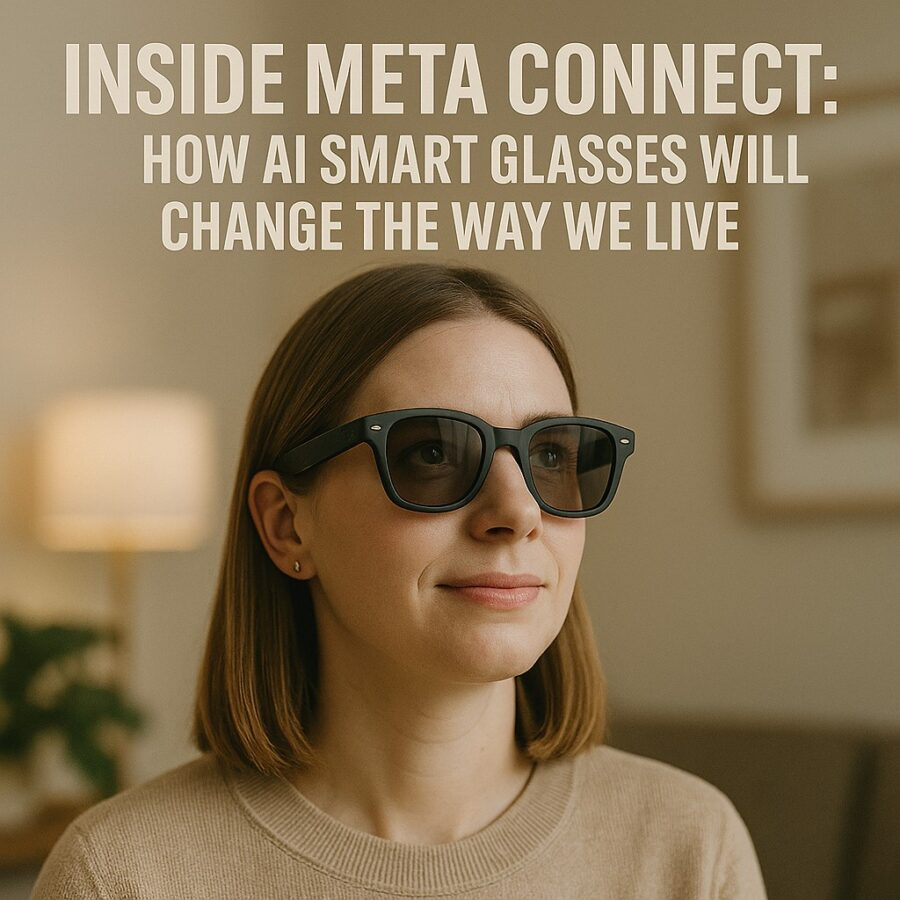Views: 2
If you wanted a preview of daily computing beyond phones, Inside Meta Connect AI Smart Glasses was the headline to watch. At Meta’s annual event, the company unveiled a family of wearables that push artificial intelligence from your pocket to your face, with real-time awareness, translation, and glanceable displays. The showcase centered on three lines: a brand-new Meta Ray-Ban Display with an in-lens screen and a neural wristband, refreshed Ray-Ban Meta Gen 2 glasses for creators and everyday use, and sport-focused Oakley Meta Vanguard glasses. Together they sketch a future where AI is ambient, assistive, and always within your line of sight. (Facebook)
Below, we unpack what was announced, how these devices work, why they matter, and the hard questions they raise about privacy, etiquette, and policy. Throughout, we keep the focus on one theme: Inside Meta Connect AI Smart Glasses is not a gadget story. It is a new human-computer interface story.
The big reveal at Meta Connect
Meta introduced Ray-Ban Display, the company’s first consumer glasses with a built-in visual display. A quick glance shows messages, navigation prompts, translations, camera previews, and Meta AI responses, so you can keep your head up while staying informed. Control comes from voice, touch, and a new Meta Neural Band, an EMG wristband that reads tiny muscle signals for subtle, low-friction input. The package is positioned as everyday eyewear, not lab gear. Pricing at launch is listed at 799 dollars in the United States. (Facebook)
Alongside Display, Meta refreshed its mainstream Ray-Ban Meta Gen 2 line with a sharper camera, longer battery life, and audio improvements. Video capture now reaches 3K with multiple frame rate options, quick charging delivers half a charge in about twenty minutes, and the case extends total time on the go. Meta also expanded live translation support and announced features like Conversation Focus for noisy places. Entry pricing starts at 379 dollars. (Android Central)
For athletes, the Oakley Meta Vanguard adds a centered action camera, water resistance, and fitness integrations with Garmin and Strava. Meta positions it as a training companion that can auto-capture highlights and surface real-time metrics during workouts. It launches at 499 dollars in the U.S. and Canada. (Reuters)
If last year’s Connect put multimodal AI on your glasses, this year adds a display, a neural wristband, and deeper integrations. Meta’s materials pitch the trio as steps toward a unified vision of AI wearables that live with you all day. (Meta)
The following is a referral or affiliated link that AltPenguin receives compensation for, should the link be used and the offer is completed. To provide full transparency, we at AltPenguin are stating this before you click the image below (the image will open a new page to the offer shown in the image).
How the hardware and AI stack up
Display optics and glanceability. The in-lens screen on Ray-Ban Display is designed for fast, heads-up checks rather than immersive video. You are meant to peek, decide, and keep moving. Meta frames this as technology that helps you stay present in the world while still getting assistance. (Facebook)
Input without friction. The new Meta Neural Band reads electrical signals from your wrist so tiny finger movements can act as commands. This frees you from obvious gestures and reduces social friction in public. It complements voice controls and frame taps. (Facebook)
Creator-class capture. The Gen 2 camera upgrades answer a clear use case: hands-free POV clips for social, training, and field documentation. Three-minute 3K bursts, improved low-light, and case-extended endurance make it practical to record a day in slices. (Android Central)
Fitness-first design. Oakley’s Vanguard leans into sport. A durable build, centered camera, and live metrics turn workouts into annotated sessions. The appeal is less about always-on computing and more about actionable practice feedback. (Reuters)
Software cadence. Meta’s roadmap from last year brought real-time translation, memory helpers, and new listening integrations. The company continues to add features across its glasses line, pointing to a model where AI gets better after you buy the hardware. (Facebook)
Everyday scenarios that change with AI smart glasses
Heads-up messaging and navigation
The display turns quick checks into glances. See who pinged you, accept a call, or follow a turn without fishing for a phone. This matters most when your hands are not free, whether you are carrying groceries or coaching on a field. Early demos emphasize staying present rather than staring at screens. (Facebook)
Live translation and captions
Meta highlighted multilingual features at Connect last year, and the new Display pushes that further with on-lens translations and live subtitles. For travelers, new residents, or frontline staff in global cities, this reduces friction and builds confidence in mixed-language settings. (Facebook)
Coaching, construction, and field work
With a centered camera and hands-free controls, athletes and tradespeople can record a task, ask questions about what they see, and receive step-by-step prompts while working. The Vanguard’s integrations with fitness platforms underscore that on-the-move guidance is a first-class use case. (Reuters)
Accessibility gains
Heads-up prompts, live captions, and glanceable reminders can support users with hearing differences, ADHD, or memory challenges. While Meta has not branded these as medical devices, the accessibility potential is present whenever assistance is timely and hands-free. Practical impact will depend on app support and policy guardrails. (Facebook)
Creation without a rig
Creators can shoot stabilized POV walkthroughs, first-person tutorials, or quick product demos while keeping eye contact. The Gen 2 upgrades address complaints about battery life and clarity from the first wave of users. (Android Central)
Inside Meta Connect AI Smart Glasses and the privacy reality
Smart glasses invite real questions about consent. Meta’s guidance emphasizes a front-facing capture LED that lights when recording starts and notifies if you try to cover it. There is also a separate inward notification LED for the wearer. The idea is to create a visible cue for bystanders. (Meta)
Critics argue that small lights are easy to miss in noisy or bright settings, and that social norms lag behind the technology. Reporting has highlighted incidents and even products that try to obscure the LED, raising alarms among privacy advocates. Hospitals and sensitive workplaces are already exploring bans or stricter rules to protect confidentiality and compliance. (Tom’s Guide)
From a policy lens, three guidelines are emerging:
- Clear visual signaling that cannot be disabled by stickers or hacks.
- Context policies in clinics, schools, and secure sites that define when glasses must be removed.
- Data handling transparency about where captures go, how long they stay, and how AI models interact with them.
Meta’s own materials outline privacy settings, but durable trust will require independent audits and visible enforcement in public venues. (Meta)
The following is a referral or affiliated link that AltPenguin receives compensation for, should the link be used and the offer is completed. To provide full transparency, we at AltPenguin are stating this before you click the image below (the image will open a new page to the offer shown in the image).
Workplaces and classrooms will feel the shift first
Employers see both upside and risk. On the upside, heads-up checklists, step confirmation, barcode or QR recognition, and on-the-spot translation can raise quality in logistics, field service, and hospitality. On the risk side, compliance, trade secrets, and customer privacy demand strict governance. Counsel is already advising firms to write smart-glasses policies that mirror phone and camera rules, with additional standards for on-lens displays and continuous microphones. (California Employment Law)
In classrooms, the calculus is similar. Language labs and shop classes could benefit from hands-free prompts. Exams and lectures raise integrity and consent issues. Expect schools to treat wearables as test-day prohibited items while experimenting with supervised labs and accessibility pilots.
How Meta’s lineup compares to last year’s trajectory
At Connect 2024, Meta focused on multimodal AI on Ray-Ban glasses, new media integrations, and a first look at Orion as a pure AR research prototype. The message was that voice assistants gain power when they can see the world. In 2025, Inside Meta Connect AI Smart Glasses adds a display and a neural wristband, turning “see and say” into “see, say, and subtly act.” This closes the loop from perception to control. (The Verge)
The sport-centric Vanguard broadens the audience beyond style and creators. And the Gen 2 upgrades refine the mass-market pitch: better camera, better battery, better audio, more countries. (Android Central)
What this means for phones, watches, and the next interface
No device kills the smartphone overnight. But history shows that interfaces can shift where we do our quick checks. Watches moved notifications from pockets to wrists. Inside Meta Connect AI Smart Glasses attempts to move glance tasks from wrists to lenses. Short interactions like “who texted,” “what is that sign,” or “what is my next turn” are the first to migrate.
If the display is bright, the Neural Band is reliable, and AI responses are fast, then frequent micro-tasks move to glasses. The phone remains for long replies, deep reading, and complex editing. That division mirrors how watches coexist with phones today. (Facebook)
The creator economy angle
First-person video is sticky content. Hands-free hyperlapse, slow motion, and stabilized clips align with the short-form platforms creators use daily. A glasses-first capture flow also lowers the barrier for educators, coaches, and service professionals who want to show work from their perspective. The Gen 2 roadmap reads like a direct response to that audience. (Android Central)
Health, safety, and etiquette
The new display is meant for glances, not immersive visuals. Still, any heads-up content raises safety questions. Good etiquette will look like:
- Removing glasses in private or sensitive spaces.
- Announcing before recording in small groups.
- Respecting no-camera policies even if the LED is on.
- Using Conversation Focus responsibly in public so people know when microphones are active. (Android Central)
Hospitals, counseling centers, and government offices will likely codify rules. The conversation will resemble earlier debates about camera phones, but with extra care given to always-on AI and in-lens prompts. (LBMC)
Costs, availability, and who these are for
- Ray-Ban Display: 799 dollars at launch in the United States with in-lens display and Neural Band support. Targeted at early adopters who want heads-up computing without bulky headsets. (Facebook)
- Ray-Ban Meta Gen 2: starting at 379 dollars, with camera and battery upgrades, rolling to more markets. Aimed at creators and everyday hands-free convenience. (Android Central)
- Oakley Meta Vanguard: 499 dollars, fitness integrations, and rugged design for athletes. (Reuters)
Meta’s site aggregates the lines under a single AI glasses category, signaling a portfolio strategy rather than one-size-fits-all hardware. (Meta)
The following is a referral or affiliated link that AltPenguin receives compensation for, should the link be used and the offer is completed. To provide full transparency, we at AltPenguin are stating this before you click the image below (the image will open a new page to the offer shown in the image).
What could go wrong, and how to evaluate the tradeoffs
Battery and thermals. Display and continuous AI create heat and drain. Gen 2’s expanded case endurance is a practical hedge, but real-world results will vary by capture habits. (Android Central)
Social acceptance. LED indicators help but do not solve consent in crowded spaces. Third-party stickers that obscure LEDs show how fragile signaling can be without regulation. Expect more scrutiny and potential platform enforcement. (The Economic Times)
Security and data handling. Enterprises will demand clarity on storage, retention, and model training boundaries for captured data. Firm answers and admin controls will be decisive in regulated industries. Employers are already drafting policies. (California Employment Law)
Feature drift. AI features that seem magical at launch can degrade if models or integrations change. Buyers should watch Meta’s update cadence and model transparency statements to understand long-term value. (Facebook)
A practical adoption playbook for teams
- Start with a single workflow. Pick a use case where heads-up guidance reduces errors or saves time, such as multilingual customer check-ins or warehouse picking.
- Write a capture policy. Specify where glasses are allowed, how to notify others, and what data cannot be recorded.
- Train on etiquette. Teach staff how the capture LED works and when to remove devices. Display signage for customers. (Meta)
- Measure outcomes. Compare error rates, time to complete, or satisfaction before and after.
- Iterate with IT and legal. Update controls as features ship, and keep a human in the loop for edge cases.
Where the roadmap points next
Meta’s Connect narrative now includes three pillars: perception, display, and subtle input. Last year was about giving AI eyes. This year adds a screen for glanceable output and an EMG band for quiet control. The unresolved piece is full AR, which Meta still treats as a research horizon under projects like Orion. Inside Meta Connect AI Smart Glasses suggests Meta will bridge to that horizon by making today’s glasses more helpful month after month. (The Verge)
The following is a referral or affiliated link that AltPenguin receives compensation for, should the link be used and the offer is completed. To provide full transparency, we at AltPenguin are stating this before you click the image below (the image will open a new page to the offer shown in the image).
Bottom line
Meta’s latest lineup answers a simple question with big consequences: what happens when AI lives at eye level. Ray-Ban Display brings a glanceable screen and a neural band to everyday frames. Ray-Ban Meta Gen 2 doubles down on creator-friendly capture and battery life. Oakley Meta Vanguard brings training feedback to athletes. Together they make a credible case that many of our phone checks can move to lenses, especially for navigation, translation, short replies, quick captures, and coaching.
The promise is real convenience. The price is negotiating new norms. Clear signaling, context rules, and honest data policies will determine whether society embraces or resists this shift. For now, the trajectory is set. Inside Meta Connect AI Smart Glasses is how a phone era begins to hand off micro-tasks to a lighter, faster interface that looks you in the eye. (Facebook)
Sources
- Meta announcement of Ray-Ban Display and Neural Band; product overview and positioning. (Facebook)
- Meta Connect 2025 day-one keynote recap and AI glasses strategy. (Meta)
- Ray-Ban Meta Gen 2 camera and battery upgrades; pricing and markets. (Android Central)
- Oakley Meta Vanguard launch details and fitness integrations. (Reuters)
- Ongoing feature expansions and integrations from Connect 2024. (Facebook)
- Privacy indicators and guidance for bystanders and wearers. (Meta)
- Reporting and analysis on privacy concerns and LED-obscuring accessories; workplace policy considerations. (Tom’s Guide)





](https://altpenguin.com/wp-content/uploads/2025/08/veed-ad.webp)
